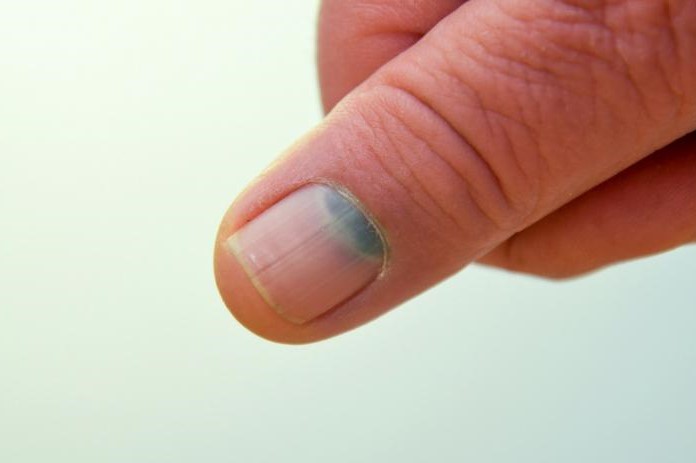
Nail melanoma: prevention and early diagnosis
Nail melanoma: This article draws from the paper by Dr Nevice Davis, an Australian surgeon and researcher, published in 1978 and known as ‘The Signs of Melanoma’
It highlights the fact that while melanoma kills about 1500 Australians each year, many of these deaths could be avoided if the telltale signs of melanoma were recognised early.
People who can recognise these signs do not necessarily have to be doctors.
Family members, friends and non-medical personnel such as podiatrists, beauticians and physiotherapists should be informed about how to recognise the signs of melanoma.
Nail melanoma, a case of astute observation and timely intervention
A 13-year-old girl had seen a poster with pictures of cutaneous melanoma and nail matrix melanoma in her doctor’s waiting room.
The girl pointed out to her 25-year-old science teacher that the dark streak running down the nail of her thumb was very similar to the melanoma she had seen on the poster.
The girl’s teacher had already noticed the dark line on her fingernail for more than a year, seeing it grow over time.
Alerted by his student’s comment, he consulted his general practitioner who arranged for a biopsy to be taken.
The latter confirmed the presence of a malignant melanoma at an early growth stage, i.e. before invasion of the deep dermal layer rich in blood vessels.
Amputation of the finger was not necessary and surgical excision of the nail bed affected by the tumour was sufficient and definitive.
Nail matrix melanomas are uncommon (which is one of the reasons they are so dangerous)
In Australia, the mortality rate for melanoma is about 10% while for nail matrix melanoma it is close to 50%.
Melanomas are initially confined to the epidermis and at the ‘melanoma in situ’ stage healing is achieved by simple surgical removal.
Once melanomas invade the dermis they can spread through the blood and lymph vessels with fatal consequences.
How to prevent mortality from nail melanoma
The risk of metastatic spread increases as the melanoma deepens into the deeper layers of the skin.
The only way to prevent mortality from melanoma is to recognise and surgically remove any suspicious lesion as early as possible before it can spread through the blood and lymph vessels, and this means recognising the ‘signs’ of its initial manifestations as early as possible.
Some benign manifestations are quite common in people of a dark phototype and produce pigmented streaks in more than one nail at the same time.
Melanoma should be suspected if the pigmentation affects only one nail (and especially if it appears after the age of puberty and enlarges over time).
Health professionals who have the opportunity to observe nails on a daily basis under magnification of lenses are podiatrists and professional beauticians.
Familiarising these practitioners with the salient features of malignant lesions may give the therapist the opportunity to save their client’s life.
Unfortunately, not all melanomas of the nail matrix are pigmented
Amelanotic melanomas can develop on any skin area including the nail matrix.
In the latter case we will not be able to observe any pigmented stria, but the main telltale sign of the malignant lesion may be either repeated bleeding under one nail without a traumatic cause or abnormal growth of sub- and periungual tissues.
What to remember about nail melanoma
Not all melanomas are caused by sun exposure.
Melanomas that can be easily detected in their daily practice by podiatrists and professional beauticians include those of the nail matrix and those located in the palm and plantar regions.
In contrast to the more common melanomas, the latter frequently occur in people with a dark phototype.
People are often alarmed by the sudden appearance of abnormal pigmentation under the nails and generally seek advice from their health professional.
Once informed about the premonitory signs of nail matrix melanoma it will be easy to detect them early, just stay awake and alert!
For more information: www.findamelanoma.blogspot.com.au
Excerpted from the article ‘Malignant nail art… Malignant melanoma writes its message on the skin with its own ink…’ from The Australian Beauty Therapist Magazine, by Dr Cliff Rosenthal, Associate Professor, School of Medicine, The University of Queensland.
Read Also:
Emergency Live Even More…Live: Download The New Free App Of Your Newspaper For IOS And Android
Melanoma: Prevention And Dermatological Examinations Are Essential Against Skin Cancer
Epidermolysis Bullosa And Skin Cancers: Diagnosis And Treatment
Skin: What To Do In Case Of Folliculitis?
Childhood Psoriasis: What It Is, What The Symptoms Are And How To Treat It
Dermatological Examination For Checking Moles: When To Do It
What Is A Tumour And How It Forms
Rare Diseases: New Hope For Erdheim-Chester Disease
How To Recognise And Treat Melanoma
Moles: Knowing Them To Recognise Melanoma
Skin Melanoma: Types, Symptoms, Diagnosis And The Latest Treatments
Nevi: What They Are And How To Recognise Melanocytic Moles


